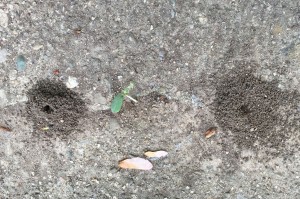There are many types of ants which infest houses in the United States. Pavement ants (tetramorium caespitum) is one of the most common ant types which is commonly found in houses. Basically, it is an early 19th century native to Europe.
In the sixteenth and seventeenth centuries, these pests were carried to the United States in the merchant vessels. In order to provide weight to the ships, soil was loaded onto the ships which were carried from Europe to the United States. In order to carry the ship across the Atlantic, soil was removed and goods were loaded once in the port. The pavement ant is found from New England to the Midwest and in the Southern areas through the Mid-Atlantic States to Tennessee. It lives in the soil. Additionally, it is found in California and Washington.
Identification:
The pavement ant is approximately 2.5-4mm in length. Their color shades range from dark brown to black. They may either have parallel furrows or lines on their head and thoracic region. Pedicel is the region which connects the thorax and the abdominal region. Their pedicel is divided into two segments. They also have a stinger in the last abdominal segment. Their dorsal thoracic region has two spines on its posterior end that project upwards to the rear.
The reproductive ants (queens) are twice the size of the worker ants. The swarmers or reproductive ants are winged. Moreover, their head and thoracic region is also furrowed. On the body of males, spines are absent but they are evident on the female body.
Biology:

As soon as they emerge, these ants mate. Queen ants soon burrow into the soil where she lays eggs for the next progeny. After a period of two or three months, worker ants develop. Their colonies are mostly found in the building slabs and in the sidewalks. They are also found in large rocks. Ants enter buildings through cracks in the walls of the foundation and the interior slabs. We can see small soil particles and sand piles on the crack areas and concrete slabs or on the top of the foundation walls. There, ants deposit debris from their excavated nests. These cracks can also be found in the side walls during the warmer months.
Host and feed of pavement ants: These ants feed on a variety of foods such as sweets, nectar, fruit, sugar, and syrups. They store some food such as dead insects, grease, small seeds, etc. in their nests for future use. In short, they can consume each and every morsel of food which falls to the ground.
Behavior:
Pavement ants have stingers. Still, they do not bite until they are disturbed. The venom of pavement ants is not poisonous, yet it may cause an allergic reaction in some.
Other Pavement Ant Facts:
- Pavement ants do not cause any structural damage.
- The larvae of butterfly Mymecophilous lycaenid sometimes lives in the nest of pavement ants to seek protection and secrete carbohydrates in return as a food for pavement ants.
